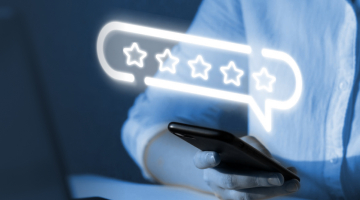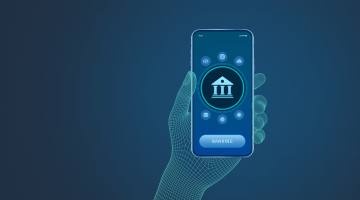

Risks of mobile banking apps: How banks can overcome
Mobile banking has become a full-fledged service that allows consumers to get information about transactions promptly, make payments, and consult. Consumers can issue and manage their cards directly on their mobile phones. Users of mobile banking apps can also send complaints and requests. With better user experience, fingerprint authentication, and push notifications with one-time passwords (OTP) for confirming transactions, the popularity of mobile banking skyrocketed.
Today, daily banking services have become increasingly closer to consumers. Within a few years, banks managed to reach a great number of customers via mobile devices, increase the number of intergenerational users, and improve customer experience and satisfaction. Banks gave people what they wanted—the possibility to manage their money on the move.
However, with increased popularity comes increased risk. How safe is online banking on a mobile phone? Recently, the number of malware programs aimed at stealing bank users’ data has greatly increased. The malware may actually look like a genuine bank’s mobile app. When people try to access their accounts, scams may steal their credentials.
That was only one example of how users’ data can be compromised. Let’s find out what other threats mobile banking faces today. Further, we’ll offer some recommendations for banks on how they can overcome these risks to retain their clients and provide them with high security.
Need secure banking software? Here’s how we do this!
Why mobile apps can be vulnerable?
As a vetted mobile app developer, DICEUS realizes that many apps carry their vulnerabilities inside. These are related to coding errors and design flaws careless or inexperienced app creators let happen or neglect to eliminate. However, there are some external reasons that threaten mobile banking app security.
- Nature of data apps store. All mobile apps, in general, and banking apps, in particular, are repositories of sensitive information. Most users recklessly keep their physical and electronic addresses, social security numbers, payment details, and other data on their apps to streamline and accelerate their activities. Being aware of such imprudence, cybercriminals exploit security gaps and get hold of personal and financial information via data breaches.
- Competition in the realm. Poised to outsell their rivals in the cutthroat struggle for the consumer, many hungry-for-fast-income companies launch their software products in terrible haste. As a result, mobile banking app security issues aren’t the top priorities for such organizations. Besides, eager to enhance user experience, they equip their apps with extra convenience capabilities (like one-click transactions), which increases risks associated with mobile banking.
- Novelty of the field. Mobile banking is a disruptive sector whose history is unraveling right before our eyes. It means that all standards in the niche (including security regulations) are being introduced on the hoof and are often substandard. The absence or inadequacy of well-established security norms makes app protection a challenging endeavor.
- Device fingerprints are volatile. A mobile gadget’s unique identity is assigned via its fingerprint. However, there are a plethora of ways to change this—from regular app updates to complex device hacking tools employed by scammers. Once this happens, accurate device identification leveraged for fraud protection and prevention is next to impossible.
- Fraudulent and fake mobile banking apps. Cybercriminals are getting ever more inventive, trying to fool people out of their money or gain access to their personal and financial data. They launch products that look like genuine banking apps but are utilized to break into people’s accounts and wreak havoc there.
All these factors question the safety of mobile banking. What are the most typical mobile banking risks financial service consumers can encounter?
Is mobile banking safe enough? 10 possible risks for banks and their consumers
Mobile apps, especially those that process financial data, are quite vulnerable to malware risks, breaches, fraud, and cyberattacks. When these problems arise, they can have negative effects on app users and banks. The latter can lose their customers if they don’t have appropriate guidelines and mechanisms to resolve security issues. Below, the most frequent risks are highlighted.
Malware risks
Some antivirus companies state that mobile malware keeps growing in scope and complexity. The number one risk is hidden apps, which account for ⅓ of all mobile attacks. Hidden apps run as a background service once the user closes the app. Among future threats, malware is expected to become more targeted (e.g., ad click spam/fraud, sending phishing emails, service attacks, etc.).
App vulnerabilities
Although mobile banking apps are considered to be more secure than entering your account via a browser, there’s still a certain number of risks. Not all developers take into account the risks of money laundering and fraud during development. Security vulnerabilities have such negative effects as stolen credentials. For example, an e-store can use your banking login data to expedite a transaction.
Related article: AI in banking industry: Use cases and key benefits
Unsecured Wi-Fi public hotspots
Free Wi-Fi is no longer a luxury. It is actually a must-have for any public place. Thousands of people use public hotspots to access their mobile banking. However, that’s not secure. Scams may set up their Wi-Fi spots near the place where you use your credentials to log in to your bank app. They create almost the same name for the wireless network, for example, Burger Place and Burger Place1.
ID vulnerabilities
Fingerprint authentication was considered one of the securest ways to log in to your account. However, scams have already invented new means to bypass a security seal. Among the most popular approaches to circumvent the fraud detection systems and commit identity theft is to hide IP addresses by using virtual private networks (VPN).
Remote deposit fraud
Depositing checks to bank accounts remotely is very convenient for most consumers. However, this may lead to the capturing of your checks by scams. The latter know some ways of accessing databases containing remote deposit checks. Once they have your image, they can copy it and use the services of money mules.
Poor API protection
To provide end-to-end financial services, banking apps interact with multiple third-party solutions via APIs. They function as a gateway to structured and ready-to-use information – just what cybercriminals are looking for. However, app creators often overlook the security of these software elements, exposing user data to compromising threats.
Client-side injections
These are targeted attacks aimed at unauthorized access to the data the banking app stores. To obtain it, hackers utilize SQL injections, local file inclusions, and other malevolent methods. The major way to counter such attempts is to have a proper input validation system in place.
Unsafe data storage
Banking apps usually keep PIN codes, passwords, card numbers, login details, and other sensitive information locally on your mobile phone. To make matters worse, such data is often not encrypted altogether. If a tech-savvy wrongdoer gets hold of your gizmo, they can discover all they need to rob you or steal sensitive data for evil purposes.
Hardcoded keys or passwords
Some lazy or hasty developers hardcode passwords, OAuth keys, or API keys and keep them somewhere in the code to make the app’s support, debugging, and implementation easier. Once discovered, these values open the doors to the app’s back-end system-wide and allow unscrupulous people to exploit the solution in many ways.
Subpar source code security
Source code is the building block used to create the app. If developers don’t safeguard it, they not only endanger their intellectual property rights. Since source code is often bound with APIs, encryption keys, authentication tokens, and other vital data, its accessibility provides a ready penetration channel for cybercriminals. But even if the vendor keeps its own source code secure, the solution can be compromised because of the vulnerability of third-parties’ source code involved in app creation.
To mitigate all these risks, banking app developers should institute robust security measures during the SDLC.
What kind of IT outsourcing services do banks use? Here’s the answer.
How banks can prevent security risks in mobile banking: 10 recommendations for bank CIOs
Among the most frequent factors affecting a consumer’s decision to download a mobile banking app are security issues. According to the data presented below, around 33% think that banks must better protect their sensitive data and around 28% want banks to add authentication for certain transactions.
To persuade new clients to download apps and retain existing customers, banks should adhere to a certain number of recommendations and prevent risk concerns. Below are some risk prevention measures for bank IT departments.
1. Application security audit
A software audit is one of the first risk prevention measures a bank should take. First, audit specialists assess all possible security threats that can arise while bank customers are using a mobile app. Then, they provide you with guidelines on how to eliminate these risks. As a rule, such audits are conducted in accordance with OWASP mobile security standards that include the following points:
- Sensitive data identification and protection
- Secure credentials processing
- Transferring sensitive data securely
- Correct authentication/authorization implementation
- Keeping APIs secure
- Integrating data with TPAs appropriately
- Taking into account user consent
- Implementing control over pay-for-services
Each company providing application security audits may have its own methodologies and standards. However, it’s always possible to discuss your requirements.
2. Regular application updates
Mobile banking apps can be called digital offices of banks. They provide users with a variety of helpful features and functionalities without the need to physically attend a financial institution. Thus, applications should be timely and regularly updated. Usually, these updates include bug fixes, mobile banking security improvements, Touch ID fixes, user interface changes, etc.
3. Strong brand identity (UX, UI)
A recognizable brand is also a good way to improve mobile banking security. Often, scams create alike apps to trick new customers who download a bank’s app via Google Play or App Store. Strong brand awareness and unique design are intended to ensure that users can recognize a bank’s identity.
4. Multi-factor authentication
Multi-factor authentication is one of the most effective approaches to security. Mobile app developers often use two or more factors to log in to ensure a high level of app security. This type of authorization means that end-users will use something that they are (biometrics), something that they have (card), and something that you know (password). There are many technologies providing multi-factor authentication (tokens, smart cards, biometrics).
5. A clear FAQ on security concerns
Each secure banking software should provide end-users with clear risk prevention recommendations in case of any card losses, thefts, cyberattacks, etc. Consumers should clearly know what they have to do in such cases. Thus, each bank has to develop step-by-step guidelines that are available for quick assistance to any customer.
6. Secure data transmission
The data app should be secure both at rest and in transition when it travels between the application and the bank’s server. The latter can be achieved by utilizing reliable protocols (for instance, Transport Layer Security (TLS)) and encrypting data liable for transmission.
7. Comprehensive data encryption
This measure aims to make information the app contains unreadable to unauthorized eyes. It is performed by employing an encryption algorithm (we recommend Advanced Encryption Standard – AES) with a minimum key size of 256 bits to convert such data into ciphertext. Without knowing the secret key (which may be identical or unique for encryption and decryption), no one will be able to understand the classified information in case the server is compromised or the device is stolen.
8. Secure coding practices
The best security coding practices include comprehensive input validation, proper session management, forestalling clickjacking attacks, malware penetration prevention, and API security. The latter involves utilizing various authentication mechanisms (API keys, tokens, etc.), ensuring the usage of HTTPS for all API calls, implementing rate limiting, and more.
9. Code reviews and security testing
Before the app goes live, it should undergo a thorough checking procedure, embracing penetration testing, static security testing, and dynamic security testing to troubleshoot issues, pinpoint bugs, and eliminate them. Yet, even when the app is released, the security specialists should keep an eye on its functioning and conduct regular code reviews to detect cross-site scripting and injection flaws that may find their way in during the product’s usage.
10. Incident response plan
No matter how hard you try to prevent them, security breaches and accidents do happen. To mitigate their consequences, organizations should have a robust plan for such emergencies. It should provide a straightforward algorithm for identifying, containing, and eradicating issues, as well as outline the recovery procedure. A mission-critical element of such a plan is the review and analysis stage aimed at forestalling future accidents.
The suggested steps can be effective if they are planned and implemented by high-profile security experts with in-depth industry-specific skills.
What DICEUS offers
Our company has strong expertise in developing software systems, applications, and other solutions for banks. In terms of mobile banking security, we can offer the following services:
- Consulting on cybersecurity
- Software audit
- Application development
- Penetration testing
We start our collaboration with an in-depth business analysis and develop a clear technical proposal and SRS. Tell us about your mobile banking needs, and our specialists will contact you as soon as possible.
FAQ
What are the primary security risks associated with mobile banking?
The most widespread risks related to using banking apps include malware threats, insecure Wi-Fi connection, ID vulnerabilities, poor API protection, remote deposit fraud attempts, unsafe data storage, various client-side injections, inadequate source code security, and hardcoded passwords and keys.
How can malware pose a threat to mobile banking security?
As a rule, malware is disguised as an antivirus or other useful solution that asks for permission to access the banking app. Once the entry is granted, it steals the bank client’s login and OTP data and reports it to cybercriminals, who can drain the victim’s account.
Why are unsecured Wi-Fi connections a risk for mobile banking?
If a Wi-Fi network has open access, scammers can use special equipment to intercept the data transmitted over it. By logging in via such a facility, you expose your credentials and banking information to the threat of being discovered and tampered with.
What steps can banks and app developers take to address vulnerabilities in mobile banking apps?
To let banking app users enjoy safe financial services, app developers and owners should rely on the best practices of secure coding and data transmission, introduce multi-factor authentication techniques, perform regular penetration tests and app security audits, implement comprehensive data encryption, and have a robust incident response plan in place.
Is it safe to use biometric authentication for mobile banking?
It is much safer than relying on the traditional password authentication system. Face, voice, and touch ID procedures make it much harder for cybercriminals to access your account and personal data. To make doubly sure, it is recommended to augment biometric authentication with one-time passwords. Such a 2FA system is one of the legislative requirements financial organizations must comply with.





